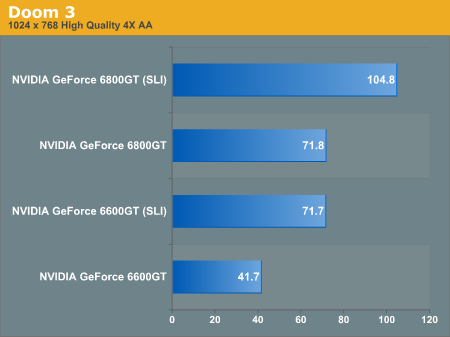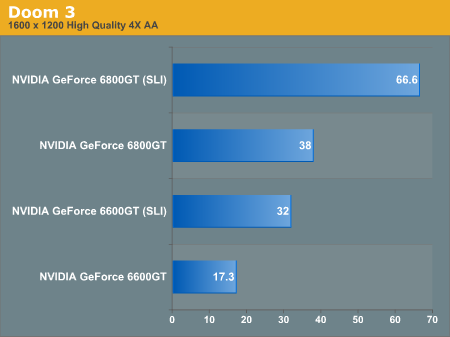NVIDIA SLI Performance Preview with MSI's nForce4 SLI Motherboard
by Anand Lal Shimpi on October 29, 2004 5:06 AM EST- Posted in
- GPUs
Doom 3 Performance
This benchmark requires no introduction - currently the most stressful game on today's GPUs, Doom 3 performance is the perfect area to look at the benefits of SLI.
Starting at 1024 x 768 we see that despite the low resolution, the GeForce 6800GT got a nice 46% performance boost from SLI. The performance improvement is much greater on the slower 6600GT as it is more GPU limited at 1024 x 768 than the 6800GT, weighing in at just under 72%.
Here the performance of two 6600GTs is equivalent of a single GeForce 6800GT.

As the resolution goes up so does the performance benefit from SLI. The 6800GT moved up to a 68% performance improvement, while the 6600GT only inched up to a 78.2% gain. The 6800GTs in SLI configuration actually make 1280 x 1024 with 4X AA smooth as butter under Doom 3.

At 1600 x 1200 we see some huge performance gains from SLI: 75.3% and 85% from the 6800GT and the 6600GT respectively. It's clear that SLI makes even the highest resolutions with AA enabled quite playable.











84 Comments
View All Comments
darkrequiem - Tuesday, November 16, 2004 - link
What I'd really like to see is how Doom3 performs with this SLI setup running in Ultra quality mode. They recommend a 512MB card for this mode, and here we have a total of 512MB between the two cards. It'd be interresting to see how many FPS can be achieved at this quality setting.MightyB - Wednesday, November 10, 2004 - link
Hmm Im gonna wait out for the ATI solution and hope they will make it possible to use two diffferent types of cards. Would love to have the new x800 All in Wonder matched with another X-series card :-) This way I can get great performance along with the much better ATI picture quality and even TV.. :-)And before you flame me being a ATI fanboy.. I own a Nvidia card.. Im talking about 2D (windows desktop) and Movies when i refer to picture quality. I see now real difference in games!
Best regards
mightyB
MiLaMber - Sunday, October 31, 2004 - link
Perhaps slightly annoying this article to those ppl who have a Geforce 6800GT, like myself, just like the fact that the NF 4 is a no go.Looks like a possible upgrade to PCI Express will be on teh cards in..18 months, but I see this as a good thing, better motherboards, a maturer PCI Express solution.
Guess could always sell the 6800gt agp when the pcie version comes out though huh lol, and then start considerin SLI again and indeed NF4.
Reflex - Sunday, October 31, 2004 - link
Thats his point, because each card does 50% no matter how much work a section of the screen has, it won't necessarily utilize both cards fully. If your wandering through UT2k4 and there are no vehicles in the sky, but there is a massive ground battle going on, you will see hardly any benefit from the Alienware setup, but you'd see a huge benefit from the nVidia SLI solution since it will give the card rendering the top half of the screen more to do rather than sitting idle.Believe what you want, but I have a bad feeling that the Alienware tech will never actually appear on the market. It was announced months ago, and now if it arrived it would more or less be an Ati only solution, since if you had nVidia cards you can do SLI natively without Alienware's technology(and nVidia's solution should be faster most of the time). It was a good attempt by them, but at this point its not worth pursuing.
GhandiInstinct - Sunday, October 31, 2004 - link
Swaid: Your ratios are a bit off, did you see the E3 demonstration? Maybe you should have another look at it. The ratio is always 50/50 even if the lower or upper half has a bit more work to be done, the thing is its only half the screen, resolution. Making the cards work a lot less than if they were single. Never the less, it's always seamless no matter how high your graphics settings.Ever heard of frame locking? Frame locking synchronizes display refresh and buffer swaps across multiple cards, preventing visual artifacts and ensuring image continuity in multi-monitor (or multiple video card) applications like simulations.
Reflex - Sunday, October 31, 2004 - link
Hell, I'm an anti-nVidia guy and I still recognize this as a nice deal for those of us who'd love a cheap way to upgrade in the future when a secondary card will be cheap.I still won't be buying it however, the 2D performance of nVidia solutions is still crap at high res, and I spend a lot more time in front of a web browser than I do in front of games. But since Civ3 is the most recent game I have purchased, I don't imagine its really much of an issue for me. A Parhelia would meet my gaming needs just fine. ;)
Swaid - Sunday, October 31, 2004 - link
GhandiInstinct,His logic is correct, while your's on the other hand needs to be double checked. In your case (X2/Video Array), we can take the an example of a situation where the upper half of the screen has a more complex scene (or more activity) going on, thus making Card 1 (video card rendering the upper half) work at 100% while Card 2 (video card rendering the bottom half) only needs to work at 80% to keep up with Card 1. Thats not an efficient solution. This is where SLI's technology can really shine. If you take that same scene thats being played through and use SLI, Card 1 will now render the upper 40% while Card 2 will render the bottom 60% and this would keep the 2 GPU's at 100% load. Now that is an efficient solution. That senario can pretty much go for all FPS games. Dynamic load balancing appears to be a better 'logical' solution. But I am willing to bet that you are an ATI fan or maybe it has to do with some sort of loyalty towards Alienware, so SLI is feeling you left behind, thus your unwillingness for reason. There are many articles that try and explain the whole situation with SLI.
Zebo - Sunday, October 31, 2004 - link
Oh and thanks Anand for this exclusive. I'm with the camp which says "single card" and "frequent upgrades" only because of noise, heat, power and very low resale when I'm finally done with the two cards.Zebo - Sunday, October 31, 2004 - link
More options are always a good thing. How can anyone be down on this tech is beyond me.GhandiInstinct - Saturday, October 30, 2004 - link
SLI requires special circuitry to be incorporated into GPUs and, for extra speed gain, into core-logic. Alienware’s Video Array technology does not require any special logic to be incorporated into graphics or system chips.This makes it less of a driver prone problem than SLI.
Over.